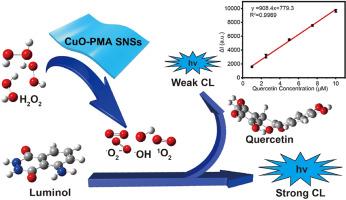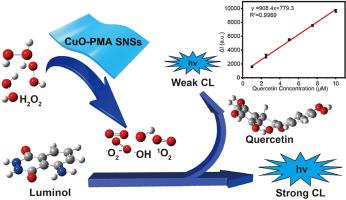Enhanced chemiluminescence with sub-1 nanometer CuO-PMA nanosheets for the sensitive detection of quercetin
IF 5.7
2区 化学
Q1 CHEMISTRY, ANALYTICAL
引用次数: 0
Abstract
Background
Chemiluminescence (CL) analysis, characterized by its simple instrumentation, high signal-to-noise ratio, wide linear range, and minimal background interference, has garnered increasing attention from researchers. Nanomaterials (NMs) have been explored to enhance CL intensity. Notably, sub-1 nanometer scale NMs are considered to hold significant untapped potential due to their size effects. The application of these sub-1 nanometer NMs in enhancing CL is anticipated to yield favorable results. Additionally, the low water solubility and bioavailability of quercetin glycosides lead to their presence in bodily fluids at only trace levels, highlighting the urgent need for efficient and rapid detection methods.
Results
In this work, phosphomolybdic acid (PMA) was incorporated into CuO to synthesize sub-1 nanometer CuO-PMA nanosheets (SNSs) using a cluster-core co-assembly strategy. Conformational and structural characterization confirmed the successful synthesis of these nanosheets. The CuO-PMA SNSs were employed to enhance the CL emission of the luminol-H2O2 system, resulting in an increase of over 1000 times. The catalytic properties of CuO-PMA SNSs significantly facilitated the decomposition of H2O2, leading to an enhanced production of reactive oxygen species, which in turn induced the CL enhancement. Given that the antioxidant effect of quercetin would consume the reactive oxygen species generated during the catalysis, a decrease in CL intensity was anticipated. A CL sensor for quercetin detection was developed based on the CuO-PMA SNSs-luminol-H2O2 system, demonstrating a strong linear relationship (R2 = 0.9969) and a low detection limit of 0.31 nM.
Significance
This research provides a strategy to enhance the CL intensity of the luminol-H2O2 system by using CuO-PMA SNSs, offering a highly sensitive assay for detecting quercetin concentrations. The method is characterized as a simple and cost-effective analytical strategy making CL analysis very attractive for chemical analysts.


利用亚 1 纳米 CuO-PMA 纳米片增强化学发光,实现对槲皮素的灵敏检测
背景化学发光(CL)分析因其仪器简单、信噪比高、线性范围宽、背景干扰小等特点而日益受到研究人员的关注。纳米材料(NMs)已被用于增强化学发光强度。值得注意的是,1 纳米以下的纳米材料因其尺寸效应而被认为具有尚未开发的巨大潜力。预计应用这些 1 纳米以下的 NMs 增强 CL 将产生良好的效果。此外,槲皮素苷的水溶性和生物利用率低,导致其在体液中的含量仅为痕量水平,因此迫切需要高效、快速的检测方法。结果在这项工作中,采用簇核共组装策略将磷钼酸(PMA)加入到 CuO 中,合成了亚 1 纳米 CuO-PMA 纳米片(SNSs)。构象和结构表征证实了这些纳米片的成功合成。利用 CuO-PMA SNSs 增强了发光酚-H2O2 系统的 CL 发射,使其增加了 1000 倍以上。CuO-PMA SNS 的催化特性极大地促进了 H2O2 的分解,从而提高了活性氧的产生,进而诱导了 CL 的增强。鉴于槲皮素的抗氧化作用会消耗催化过程中产生的活性氧,预计 CL 强度会降低。该研究提供了一种利用 CuO-PMA SNSs 增强发光酚-H2O2 系统的发光强度的策略,为检测槲皮素浓度提供了一种高灵敏度的检测方法。该方法是一种简单、经济的分析策略,对化学分析师来说是一种非常有吸引力的 CL 分析方法。
本文章由计算机程序翻译,如有差异,请以英文原文为准。
求助全文
约1分钟内获得全文
求助全文
来源期刊

Analytica Chimica Acta
化学-分析化学
CiteScore
10.40
自引率
6.50%
发文量
1081
审稿时长
38 days
期刊介绍:
Analytica Chimica Acta has an open access mirror journal Analytica Chimica Acta: X, sharing the same aims and scope, editorial team, submission system and rigorous peer review.
Analytica Chimica Acta provides a forum for the rapid publication of original research, and critical, comprehensive reviews dealing with all aspects of fundamental and applied modern analytical chemistry. The journal welcomes the submission of research papers which report studies concerning the development of new and significant analytical methodologies. In determining the suitability of submitted articles for publication, particular scrutiny will be placed on the degree of novelty and impact of the research and the extent to which it adds to the existing body of knowledge in analytical chemistry.
 求助内容:
求助内容: 应助结果提醒方式:
应助结果提醒方式:


